DC Circuits: Engineering Science Calculation and Problem Solving
VerifiedAdded on 2023/04/21
|10
|1547
|483
Homework Assignment
AI Summary
This document presents a solved assignment focused on DC circuits, covering a range of problems and calculations relevant to electrical engineering. It includes determining shunt resistance for a meter, analyzing a potentiometer circuit, applying nodal analysis to find current and power dissipation, calculating the time over which magnetic flux changes, determining the current in a conductor within a magnetic field, estimating the radius of plates in a multi-plate variable capacitor, and analyzing the time constant and voltage drops in an inductor-resistor circuit. The solutions provide step-by-step explanations and calculations, making it a valuable resource for students studying DC circuits and electromagnetic principles. Desklib provides solved assignments and past papers for students.

DC Circuits 1
ENGINEERING SCIENCE
A Calculation Paper on DC circuits By
Student’s Name
Name of the Professor
Institutional Affiliation
City/State
Year/Month/Day
ENGINEERING SCIENCE
A Calculation Paper on DC circuits By
Student’s Name
Name of the Professor
Institutional Affiliation
City/State
Year/Month/Day
Paraphrase This Document
Need a fresh take? Get an instant paraphrase of this document with our AI Paraphraser
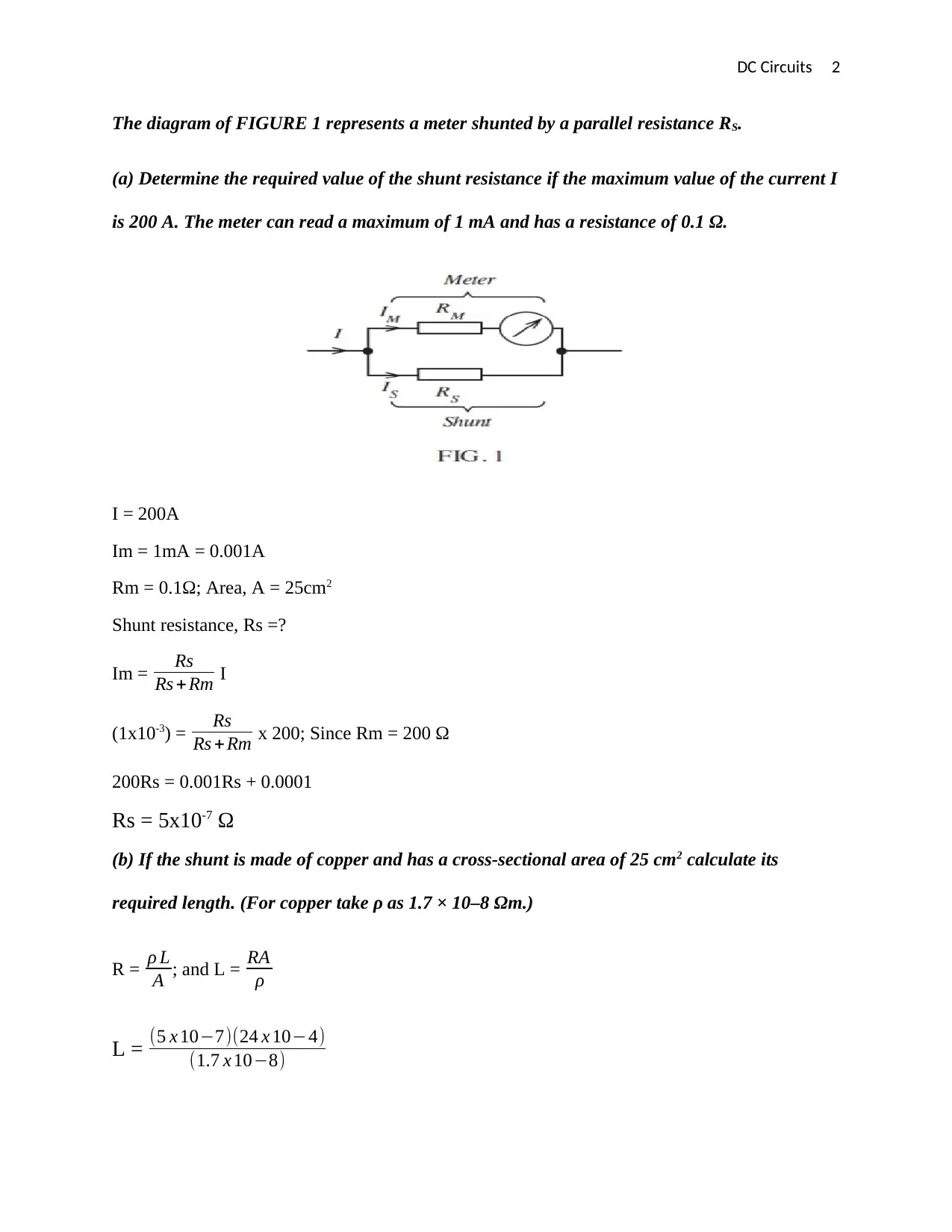
DC Circuits 2
The diagram of FIGURE 1 represents a meter shunted by a parallel resistance RS.
(a) Determine the required value of the shunt resistance if the maximum value of the current I
is 200 A. The meter can read a maximum of 1 mA and has a resistance of 0.1 Ω.
I = 200A
Im = 1mA = 0.001A
Rm = 0.1Ω; Area, A = 25cm2
Shunt resistance, Rs =?
Im = Rs
Rs + Rm I
(1x10-3) = Rs
Rs + Rm x 200; Since Rm = 200 Ω
200Rs = 0.001Rs + 0.0001
Rs = 5x10-7 Ω
(b) If the shunt is made of copper and has a cross-sectional area of 25 cm2 calculate its
required length. (For copper take ρ as 1.7 × 10–8 Ωm.)
R = ρ L
A ; and L = RA
ρ
L = (5 x 10−7)(24 x 10−4)
(1.7 x 10−8)
The diagram of FIGURE 1 represents a meter shunted by a parallel resistance RS.
(a) Determine the required value of the shunt resistance if the maximum value of the current I
is 200 A. The meter can read a maximum of 1 mA and has a resistance of 0.1 Ω.
I = 200A
Im = 1mA = 0.001A
Rm = 0.1Ω; Area, A = 25cm2
Shunt resistance, Rs =?
Im = Rs
Rs + Rm I
(1x10-3) = Rs
Rs + Rm x 200; Since Rm = 200 Ω
200Rs = 0.001Rs + 0.0001
Rs = 5x10-7 Ω
(b) If the shunt is made of copper and has a cross-sectional area of 25 cm2 calculate its
required length. (For copper take ρ as 1.7 × 10–8 Ωm.)
R = ρ L
A ; and L = RA
ρ
L = (5 x 10−7)(24 x 10−4)
(1.7 x 10−8)
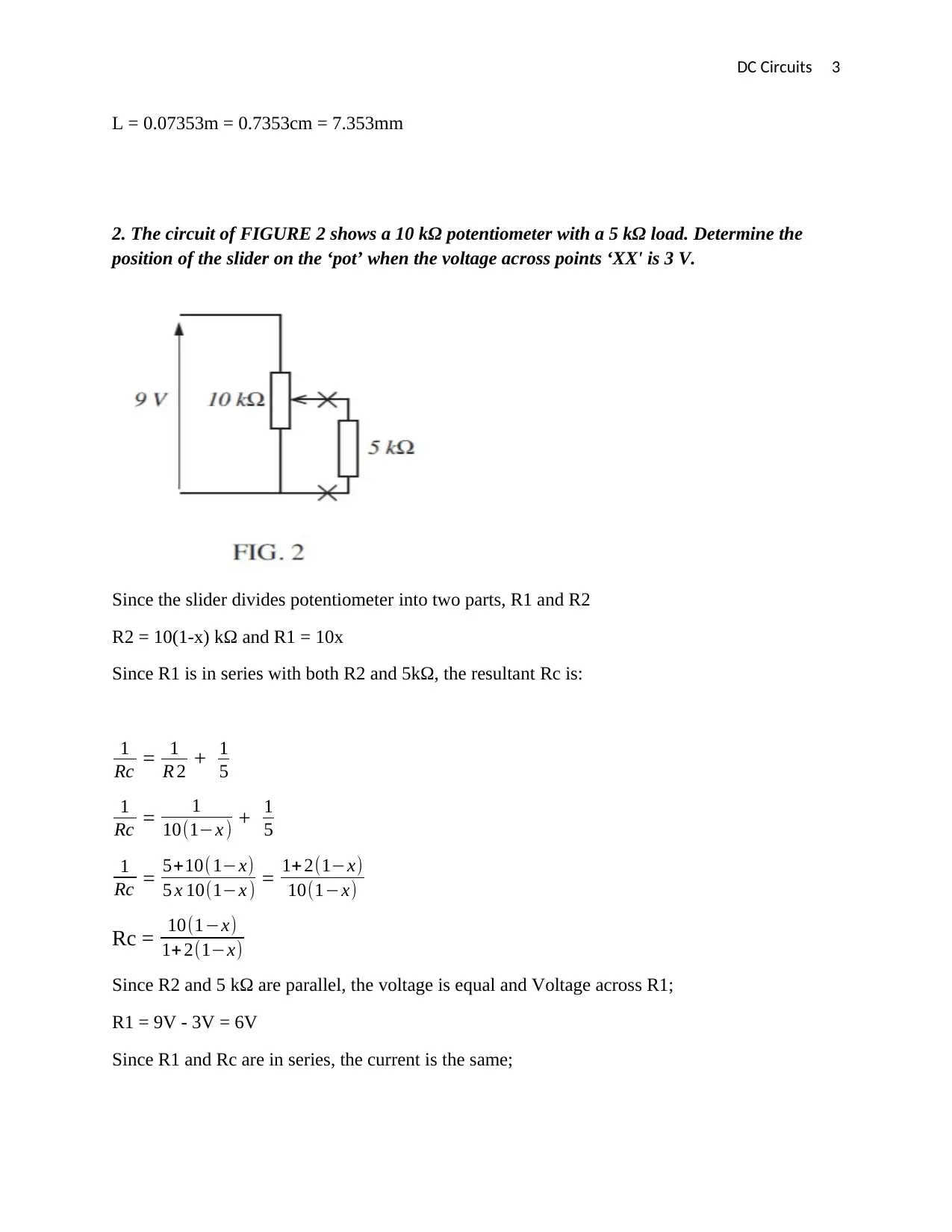
DC Circuits 3
L = 0.07353m = 0.7353cm = 7.353mm
2. The circuit of FIGURE 2 shows a 10 kΩ potentiometer with a 5 kΩ load. Determine the
position of the slider on the ‘pot’ when the voltage across points ‘XX' is 3 V.
Since the slider divides potentiometer into two parts, R1 and R2
R2 = 10(1-x) kΩ and R1 = 10x
Since R1 is in series with both R2 and 5kΩ, the resultant Rc is:
1
Rc = 1
R 2 + 1
5
1
Rc = 1
10(1−x ) + 1
5
1
Rc = 5+10( 1−x)
5 x 10(1−x ) = 1+ 2(1−x)
10(1−x)
Rc = 10(1−x)
1+ 2(1−x)
Since R2 and 5 kΩ are parallel, the voltage is equal and Voltage across R1;
R1 = 9V - 3V = 6V
Since R1 and Rc are in series, the current is the same;
L = 0.07353m = 0.7353cm = 7.353mm
2. The circuit of FIGURE 2 shows a 10 kΩ potentiometer with a 5 kΩ load. Determine the
position of the slider on the ‘pot’ when the voltage across points ‘XX' is 3 V.
Since the slider divides potentiometer into two parts, R1 and R2
R2 = 10(1-x) kΩ and R1 = 10x
Since R1 is in series with both R2 and 5kΩ, the resultant Rc is:
1
Rc = 1
R 2 + 1
5
1
Rc = 1
10(1−x ) + 1
5
1
Rc = 5+10( 1−x)
5 x 10(1−x ) = 1+ 2(1−x)
10(1−x)
Rc = 10(1−x)
1+ 2(1−x)
Since R2 and 5 kΩ are parallel, the voltage is equal and Voltage across R1;
R1 = 9V - 3V = 6V
Since R1 and Rc are in series, the current is the same;
⊘ This is a preview!⊘
Do you want full access?
Subscribe today to unlock all pages.

Trusted by 1+ million students worldwide
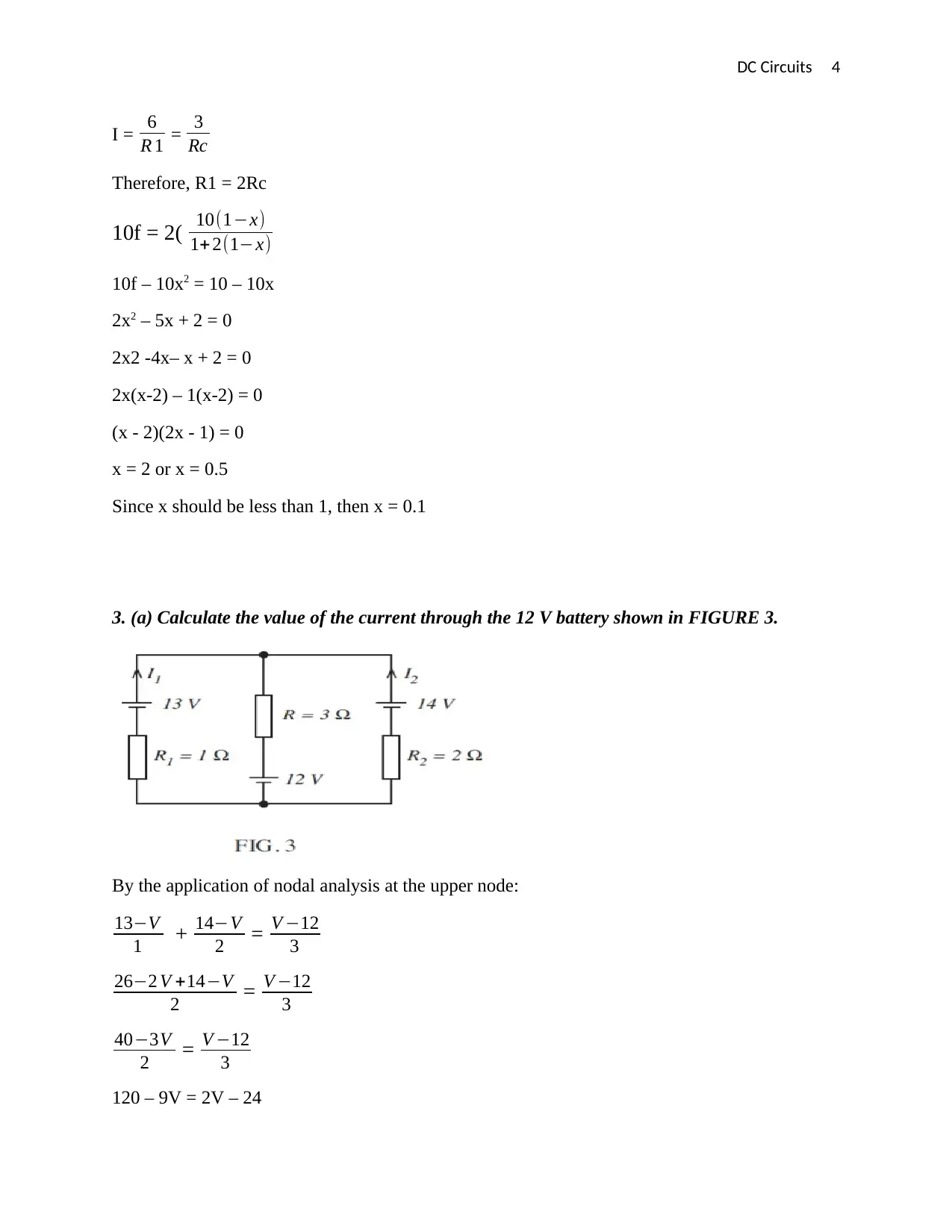
DC Circuits 4
I = 6
R 1 = 3
Rc
Therefore, R1 = 2Rc
10f = 2( 10(1−x)
1+ 2(1−x)
10f – 10x2 = 10 – 10x
2x2 – 5x + 2 = 0
2x2 -4x– x + 2 = 0
2x(x-2) – 1(x-2) = 0
(x - 2)(2x - 1) = 0
x = 2 or x = 0.5
Since x should be less than 1, then x = 0.1
3. (a) Calculate the value of the current through the 12 V battery shown in FIGURE 3.
By the application of nodal analysis at the upper node:
13−V
1 + 14−V
2 = V −12
3
26−2 V +14−V
2 = V −12
3
40−3V
2 = V −12
3
120 – 9V = 2V – 24
I = 6
R 1 = 3
Rc
Therefore, R1 = 2Rc
10f = 2( 10(1−x)
1+ 2(1−x)
10f – 10x2 = 10 – 10x
2x2 – 5x + 2 = 0
2x2 -4x– x + 2 = 0
2x(x-2) – 1(x-2) = 0
(x - 2)(2x - 1) = 0
x = 2 or x = 0.5
Since x should be less than 1, then x = 0.1
3. (a) Calculate the value of the current through the 12 V battery shown in FIGURE 3.
By the application of nodal analysis at the upper node:
13−V
1 + 14−V
2 = V −12
3
26−2 V +14−V
2 = V −12
3
40−3V
2 = V −12
3
120 – 9V = 2V – 24
Paraphrase This Document
Need a fresh take? Get an instant paraphrase of this document with our AI Paraphraser
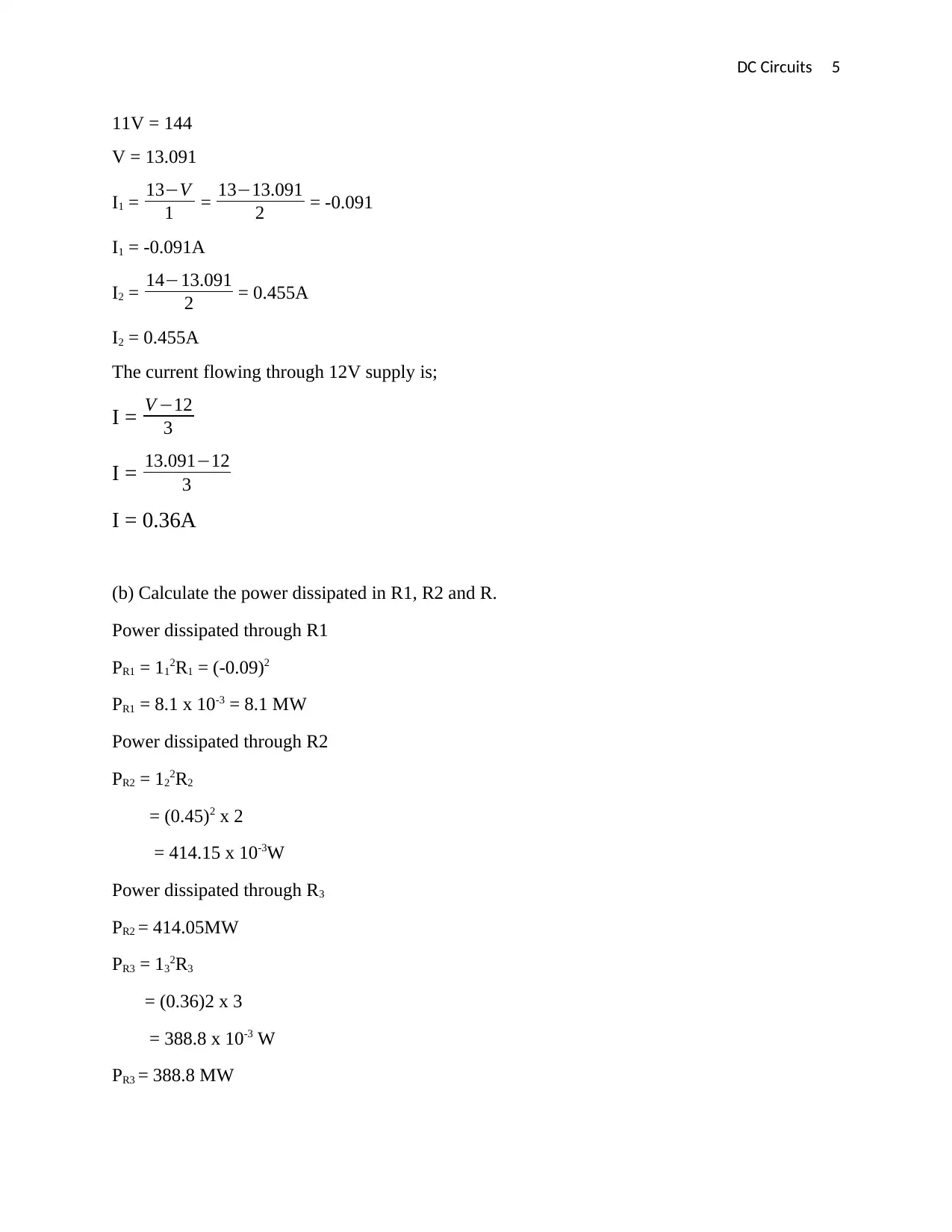
DC Circuits 5
11V = 144
V = 13.091
I1 = 13−V
1 = 13−13.091
2 = -0.091
I1 = -0.091A
I2 = 14−13.091
2 = 0.455A
I2 = 0.455A
The current flowing through 12V supply is;
I = V −12
3
I = 13.091−12
3
I = 0.36A
(b) Calculate the power dissipated in R1, R2 and R.
Power dissipated through R1
PR1 = 112R1 = (-0.09)2
PR1 = 8.1 x 10-3 = 8.1 MW
Power dissipated through R2
PR2 = 122R2
= (0.45)2 x 2
= 414.15 x 10-3W
Power dissipated through R3
PR2 = 414.05MW
PR3 = 132R3
= (0.36)2 x 3
= 388.8 x 10-3 W
PR3 = 388.8 MW
11V = 144
V = 13.091
I1 = 13−V
1 = 13−13.091
2 = -0.091
I1 = -0.091A
I2 = 14−13.091
2 = 0.455A
I2 = 0.455A
The current flowing through 12V supply is;
I = V −12
3
I = 13.091−12
3
I = 0.36A
(b) Calculate the power dissipated in R1, R2 and R.
Power dissipated through R1
PR1 = 112R1 = (-0.09)2
PR1 = 8.1 x 10-3 = 8.1 MW
Power dissipated through R2
PR2 = 122R2
= (0.45)2 x 2
= 414.15 x 10-3W
Power dissipated through R3
PR2 = 414.05MW
PR3 = 132R3
= (0.36)2 x 3
= 388.8 x 10-3 W
PR3 = 388.8 MW

DC Circuits 6
4. If the magnetic flux linking all the turns of a 50 turn coil changes from 10 mWb to 20 mWb
and induces an e.m.f. of 62.5 V in the coil, calculate the time over which the flux changes.
By the application of Faraday’s law of Electromagnetic induction;
EMF = -N dϴ
dt ; Where N is the number of turns in the coil
EMF = -N∆ ϴ
∆ t ;
∆t = N ∆ ϴ
EMF = −50 x ( 20−10 ) x 10−3
−62.5
∆t = 8x10-3 seconds
∆t = 8ms
5. A 500 mm conductor inside an electric motor has a force of 1.5 newtons exerted on it. If it
is at right angles to a magnetic field of flux density 0.6 T, calculate the current flowing in the
conductor.
L = 500mm
Force, F = 1.5N
B = 0.6T
Current, I =?
F = ILB sin ϴ
I = 1.5
500 x 0.6 sin 90
I = 0.005A
6. FIGURE 4 show the construction of a multi-plate variable capacitor having 4 pairs of
plates. The plates, when closed, are separated in air by 0.01 mm and a capacitance range of 10
to 400 pF is required.
4. If the magnetic flux linking all the turns of a 50 turn coil changes from 10 mWb to 20 mWb
and induces an e.m.f. of 62.5 V in the coil, calculate the time over which the flux changes.
By the application of Faraday’s law of Electromagnetic induction;
EMF = -N dϴ
dt ; Where N is the number of turns in the coil
EMF = -N∆ ϴ
∆ t ;
∆t = N ∆ ϴ
EMF = −50 x ( 20−10 ) x 10−3
−62.5
∆t = 8x10-3 seconds
∆t = 8ms
5. A 500 mm conductor inside an electric motor has a force of 1.5 newtons exerted on it. If it
is at right angles to a magnetic field of flux density 0.6 T, calculate the current flowing in the
conductor.
L = 500mm
Force, F = 1.5N
B = 0.6T
Current, I =?
F = ILB sin ϴ
I = 1.5
500 x 0.6 sin 90
I = 0.005A
6. FIGURE 4 show the construction of a multi-plate variable capacitor having 4 pairs of
plates. The plates, when closed, are separated in air by 0.01 mm and a capacitance range of 10
to 400 pF is required.
⊘ This is a preview!⊘
Do you want full access?
Subscribe today to unlock all pages.

Trusted by 1+ million students worldwide
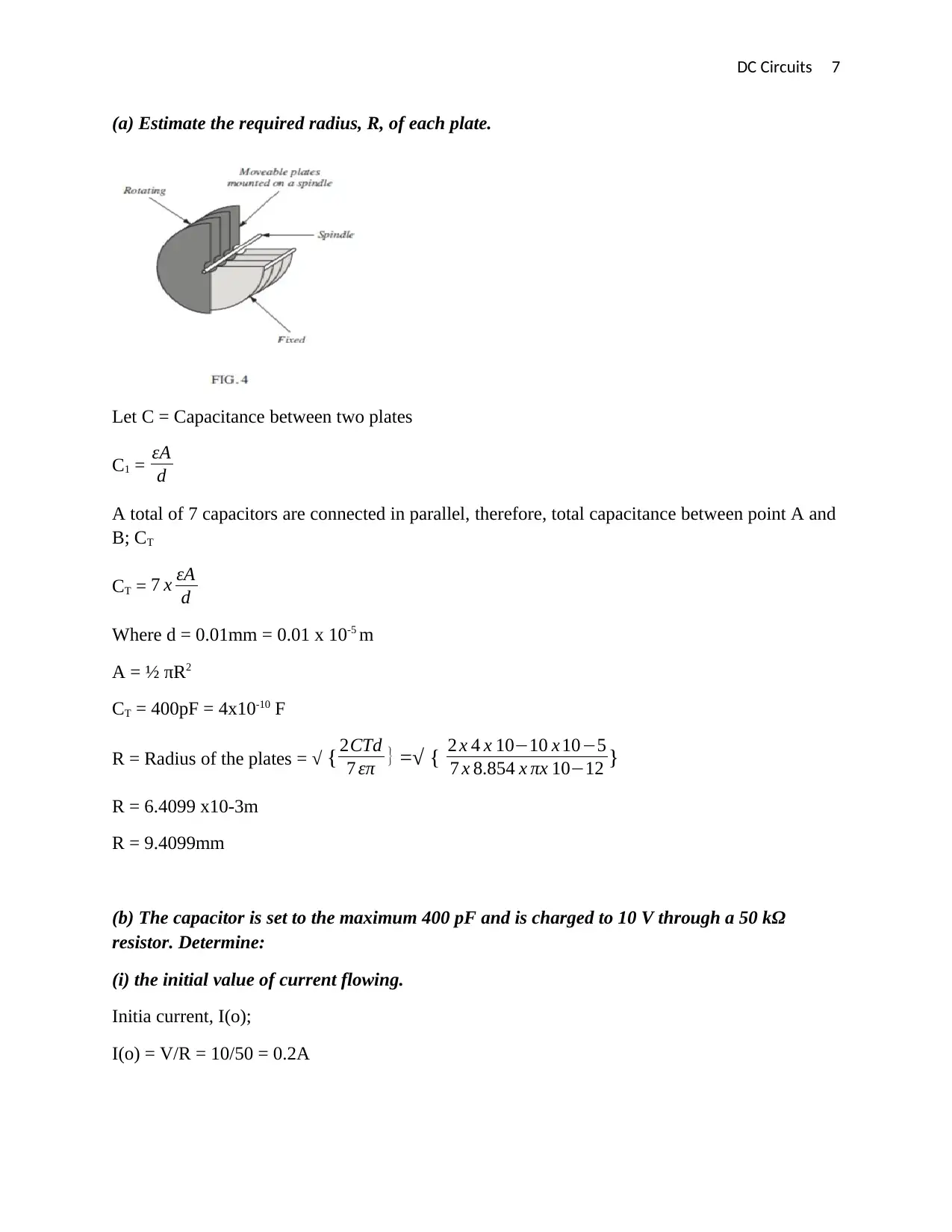
DC Circuits 7
(a) Estimate the required radius, R, of each plate.
Let C = Capacitance between two plates
C1 = εA
d
A total of 7 capacitors are connected in parallel, therefore, total capacitance between point A and
B; CT
CT = 7 x εA
d
Where d = 0.01mm = 0.01 x 10-5 m
A = ½ πR2
CT = 400pF = 4x10-10 F
R = Radius of the plates = √ {2CTd
7 επ } =√ { 2 x 4 x 10−10 x 10−5
7 x 8.854 x πx 10−12 }
R = 6.4099 x10-3m
R = 9.4099mm
(b) The capacitor is set to the maximum 400 pF and is charged to 10 V through a 50 kΩ
resistor. Determine:
(i) the initial value of current flowing.
Initia current, I(o);
I(o) = V/R = 10/50 = 0.2A
(a) Estimate the required radius, R, of each plate.
Let C = Capacitance between two plates
C1 = εA
d
A total of 7 capacitors are connected in parallel, therefore, total capacitance between point A and
B; CT
CT = 7 x εA
d
Where d = 0.01mm = 0.01 x 10-5 m
A = ½ πR2
CT = 400pF = 4x10-10 F
R = Radius of the plates = √ {2CTd
7 επ } =√ { 2 x 4 x 10−10 x 10−5
7 x 8.854 x πx 10−12 }
R = 6.4099 x10-3m
R = 9.4099mm
(b) The capacitor is set to the maximum 400 pF and is charged to 10 V through a 50 kΩ
resistor. Determine:
(i) the initial value of current flowing.
Initia current, I(o);
I(o) = V/R = 10/50 = 0.2A
Paraphrase This Document
Need a fresh take? Get an instant paraphrase of this document with our AI Paraphraser
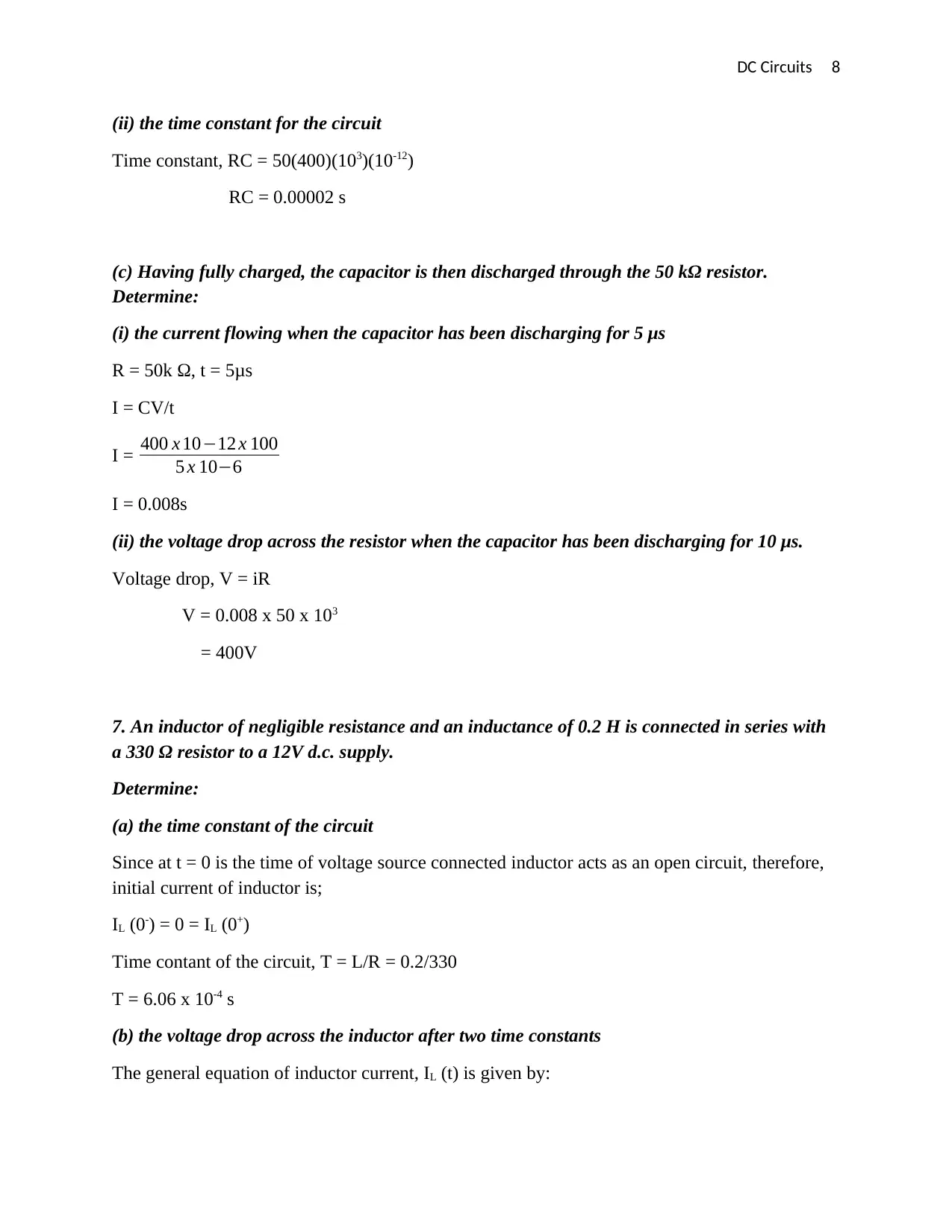
DC Circuits 8
(ii) the time constant for the circuit
Time constant, RC = 50(400)(103)(10-12)
RC = 0.00002 s
(c) Having fully charged, the capacitor is then discharged through the 50 kΩ resistor.
Determine:
(i) the current flowing when the capacitor has been discharging for 5 μs
R = 50k Ω, t = 5μs
I = CV/t
I = 400 x 10−12 x 100
5 x 10−6
I = 0.008s
(ii) the voltage drop across the resistor when the capacitor has been discharging for 10 μs.
Voltage drop, V = iR
V = 0.008 x 50 x 103
= 400V
7. An inductor of negligible resistance and an inductance of 0.2 H is connected in series with
a 330 Ω resistor to a 12V d.c. supply.
Determine:
(a) the time constant of the circuit
Since at t = 0 is the time of voltage source connected inductor acts as an open circuit, therefore,
initial current of inductor is;
IL (0-) = 0 = IL (0+)
Time contant of the circuit, T = L/R = 0.2/330
T = 6.06 x 10-4 s
(b) the voltage drop across the inductor after two time constants
The general equation of inductor current, IL (t) is given by:
(ii) the time constant for the circuit
Time constant, RC = 50(400)(103)(10-12)
RC = 0.00002 s
(c) Having fully charged, the capacitor is then discharged through the 50 kΩ resistor.
Determine:
(i) the current flowing when the capacitor has been discharging for 5 μs
R = 50k Ω, t = 5μs
I = CV/t
I = 400 x 10−12 x 100
5 x 10−6
I = 0.008s
(ii) the voltage drop across the resistor when the capacitor has been discharging for 10 μs.
Voltage drop, V = iR
V = 0.008 x 50 x 103
= 400V
7. An inductor of negligible resistance and an inductance of 0.2 H is connected in series with
a 330 Ω resistor to a 12V d.c. supply.
Determine:
(a) the time constant of the circuit
Since at t = 0 is the time of voltage source connected inductor acts as an open circuit, therefore,
initial current of inductor is;
IL (0-) = 0 = IL (0+)
Time contant of the circuit, T = L/R = 0.2/330
T = 6.06 x 10-4 s
(b) the voltage drop across the inductor after two time constants
The general equation of inductor current, IL (t) is given by:
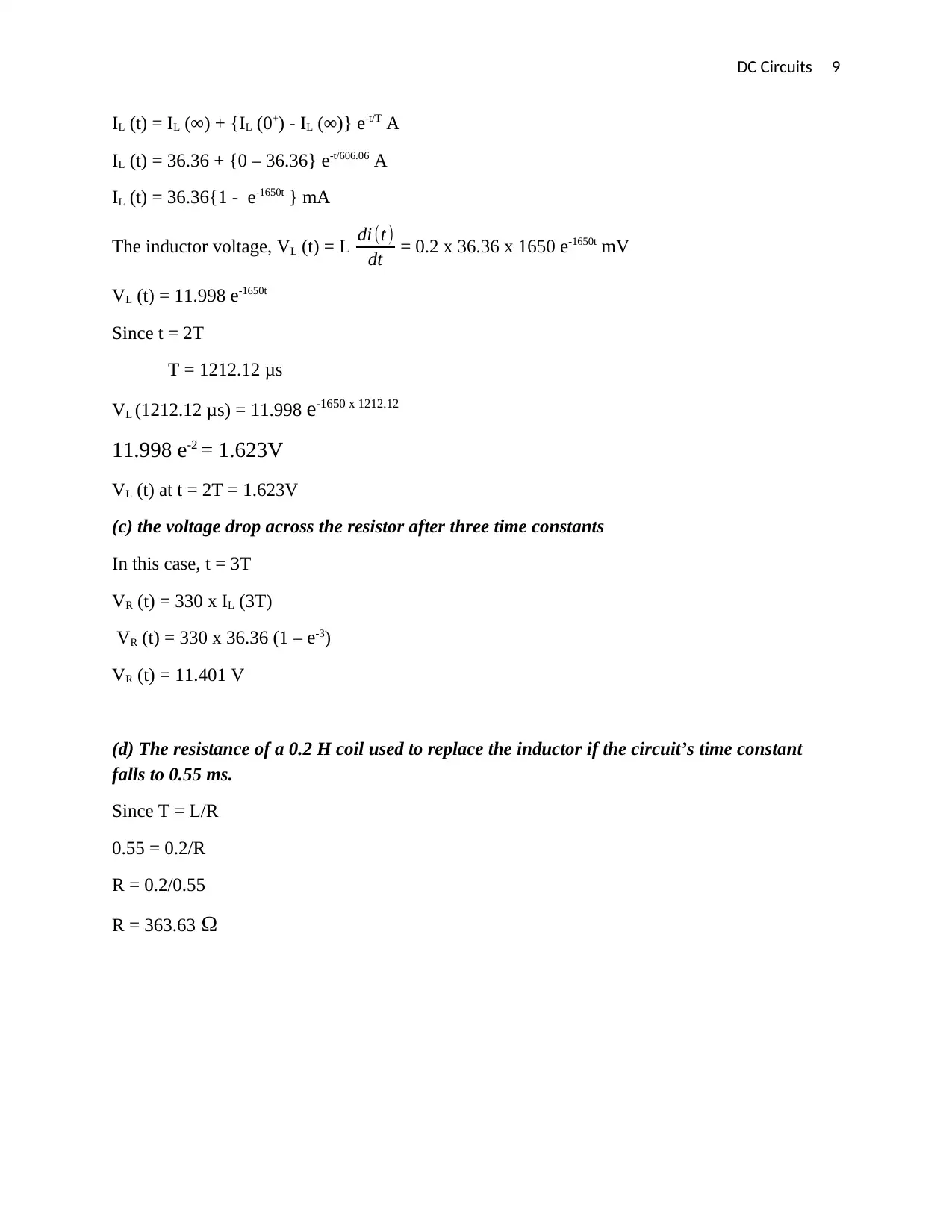
DC Circuits 9
IL (t) = IL (∞) + {IL (0+) - IL (∞)} e-t/T A
IL (t) = 36.36 + {0 – 36.36} e-t/606.06 A
IL (t) = 36.36{1 - e-1650t } mA
The inductor voltage, VL (t) = L di (t)
dt = 0.2 x 36.36 x 1650 e-1650t mV
VL (t) = 11.998 e-1650t
Since t = 2T
T = 1212.12 μs
VL (1212.12 μs) = 11.998 e-1650 x 1212.12
11.998 e-2 = 1.623V
VL (t) at t = 2T = 1.623V
(c) the voltage drop across the resistor after three time constants
In this case, t = 3T
VR (t) = 330 x IL (3T)
VR (t) = 330 x 36.36 (1 – e-3)
VR (t) = 11.401 V
(d) The resistance of a 0.2 H coil used to replace the inductor if the circuit’s time constant
falls to 0.55 ms.
Since T = L/R
0.55 = 0.2/R
R = 0.2/0.55
R = 363.63 Ω
IL (t) = IL (∞) + {IL (0+) - IL (∞)} e-t/T A
IL (t) = 36.36 + {0 – 36.36} e-t/606.06 A
IL (t) = 36.36{1 - e-1650t } mA
The inductor voltage, VL (t) = L di (t)
dt = 0.2 x 36.36 x 1650 e-1650t mV
VL (t) = 11.998 e-1650t
Since t = 2T
T = 1212.12 μs
VL (1212.12 μs) = 11.998 e-1650 x 1212.12
11.998 e-2 = 1.623V
VL (t) at t = 2T = 1.623V
(c) the voltage drop across the resistor after three time constants
In this case, t = 3T
VR (t) = 330 x IL (3T)
VR (t) = 330 x 36.36 (1 – e-3)
VR (t) = 11.401 V
(d) The resistance of a 0.2 H coil used to replace the inductor if the circuit’s time constant
falls to 0.55 ms.
Since T = L/R
0.55 = 0.2/R
R = 0.2/0.55
R = 363.63 Ω
⊘ This is a preview!⊘
Do you want full access?
Subscribe today to unlock all pages.

Trusted by 1+ million students worldwide
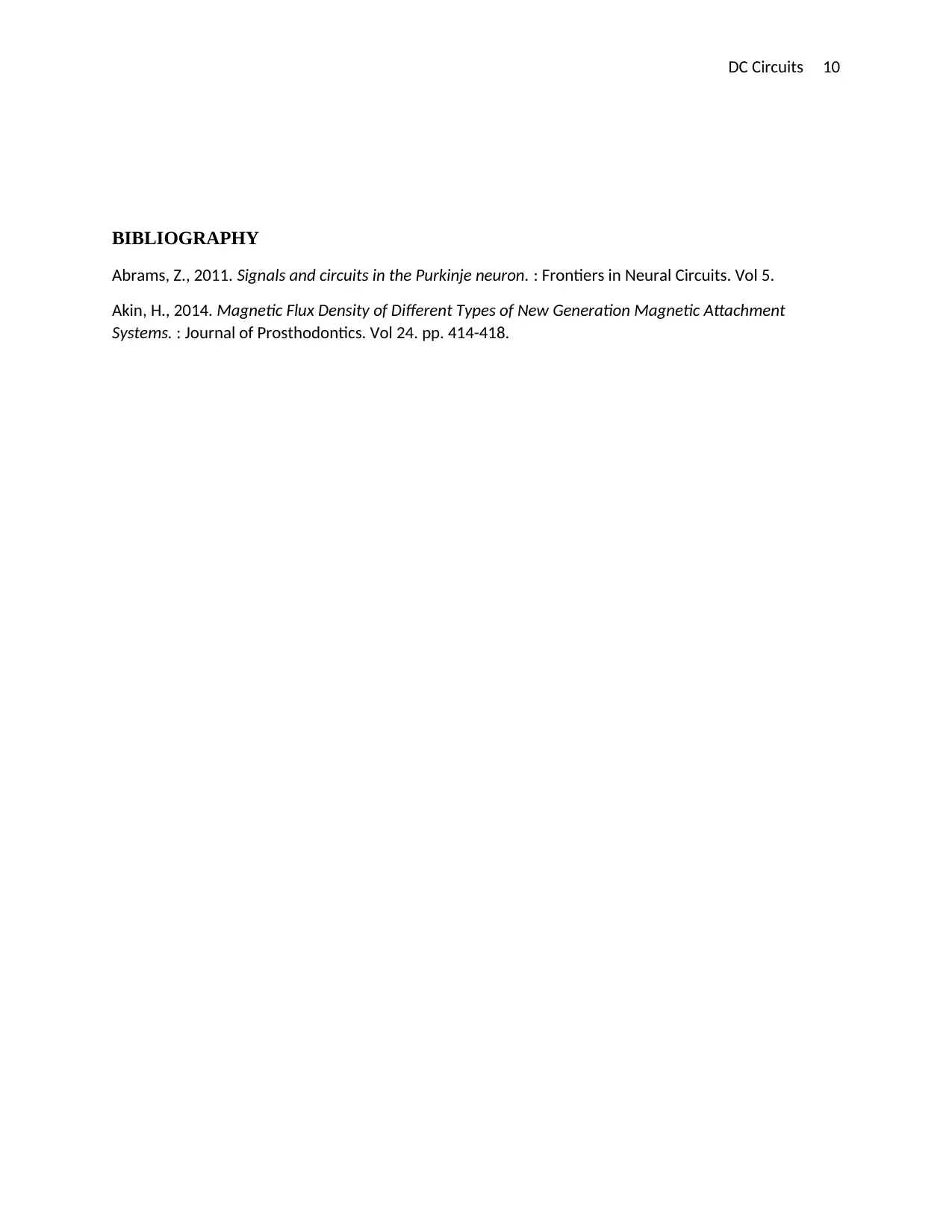
DC Circuits 10
BIBLIOGRAPHY
Abrams, Z., 2011. Signals and circuits in the Purkinje neuron. : Frontiers in Neural Circuits. Vol 5.
Akin, H., 2014. Magnetic Flux Density of Different Types of New Generation Magnetic Attachment
Systems. : Journal of Prosthodontics. Vol 24. pp. 414-418.
BIBLIOGRAPHY
Abrams, Z., 2011. Signals and circuits in the Purkinje neuron. : Frontiers in Neural Circuits. Vol 5.
Akin, H., 2014. Magnetic Flux Density of Different Types of New Generation Magnetic Attachment
Systems. : Journal of Prosthodontics. Vol 24. pp. 414-418.
1 out of 10
Related Documents
Your All-in-One AI-Powered Toolkit for Academic Success.
+13062052269
info@desklib.com
Available 24*7 on WhatsApp / Email
![[object Object]](/_next/static/media/star-bottom.7253800d.svg)
Unlock your academic potential
Copyright © 2020–2025 A2Z Services. All Rights Reserved. Developed and managed by ZUCOL.





